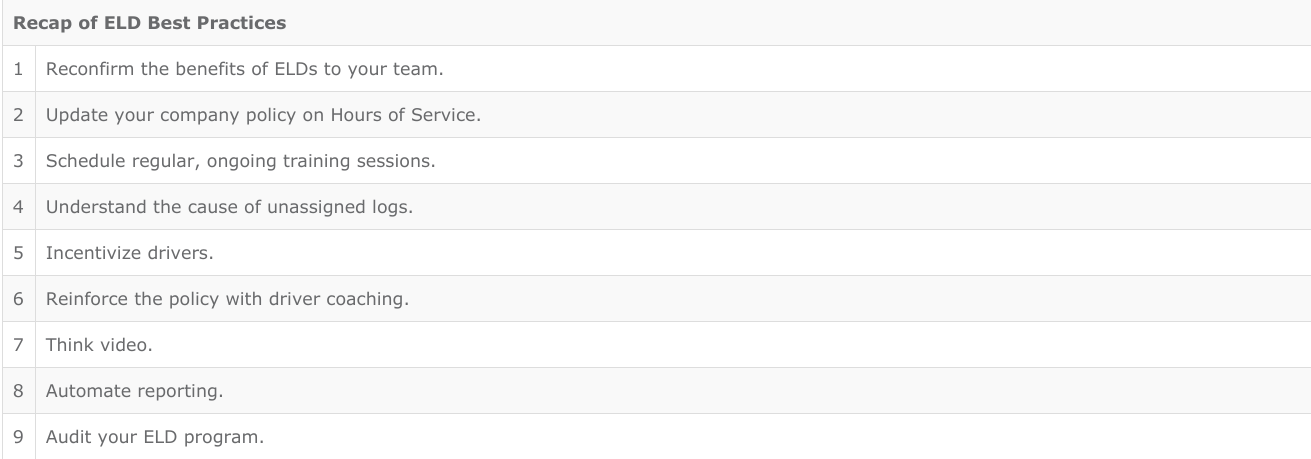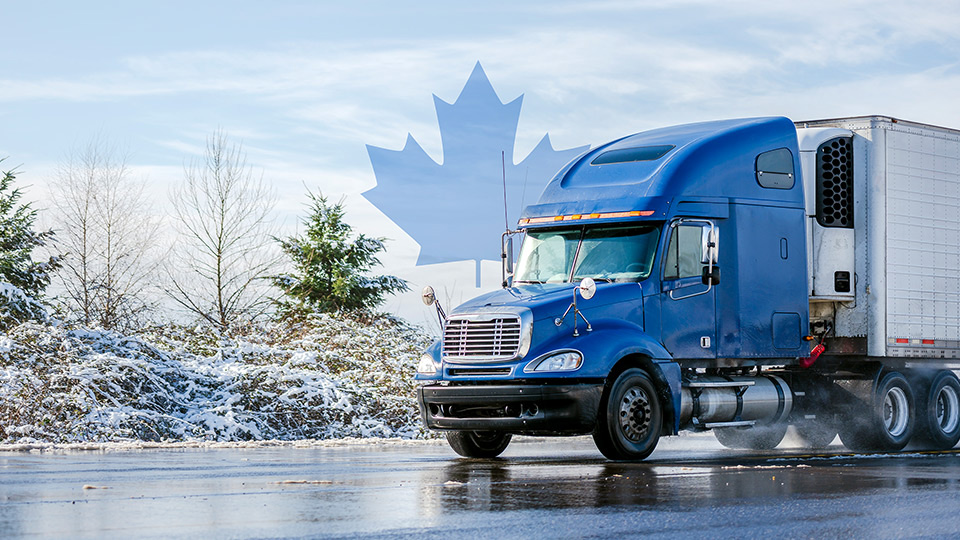
ELD best practices for fleet success: 9 helpful tips on electronic logging

Table of Contents
You bought a device for compliance. Now what?
If you are reading this now, most likely you have either deployed an electronic logging device (ELD), or you are currently grandfathered in with an existing AOBRD system in your trucks, and looking to comply with the ELD Rule. For some carriers, this was an easy task if they were already using a telematics system. For others, the process of researching and evaluating different ELD solutions may have been a months-long effort with much hard work.
But now what?
After purchasing an ELD, you could fall into one of three categories:
- “Things are going great!”
- “We’re still learning.”
- “Help! We’re struggling.”
Rolling out a new system will always come with challenges. Maybe you are new to fleet tracking technology, you have team members resistant to change, or you feel there isn’t enough time or resources to manage another system.
Compliance terminology: HOS and AOBRD Vs. ELD
HOS: Hours of Service (HOS) refers to the number of hours that truck drivers can drive and work, including the maximum number of hours that can be driven, break times, off work times, and duty cycles. “HOS” is often used as a generic term for keeping Hours of Service logs.
AOBRD: “AOBRD” is an abbreviation of Automatic On-Board Recording Device, which is a legacy way of keeping electronic logs.
ELD: Electronic Logging Devices (ELDs) replace AOBRDs as the new standard devices for recording driving time and Hours of Service (HOS). All U.S. commercial vehicle drivers and carriers subject to the ELD rule must upgrade to self-certified ELDs from AOBRDs by December 16, 2019. As of this date, AOBRDs, older logging software and paper logs will not be considered compliant.
1. Reconfirm the benefits of ELDs to your team.
In day-to-day business operations, there are many things to worry about: inspect the truck, get to the customer’s location, make the delivery, sign the paperwork. Add in ELDs on top of that and it could send anyone’s head spinning. Reminding drivers and staff of the end goal is a good way to keep everyone focused.
The goal of electronic logging is improving safety, strengthening compliance, and protecting commercial drivers.
Here are some other important benefits of ELDs:
- Saving time and money by cutting down on paperwork
- Reducing administration costs
- Increasing fleet efficiency
- Providing real-time access to information
- Minimizing compliance violations
- Helping improve CSA safety ratings
- Preventing accidents and saving lives
You can communicate your company’s ELD goal in a number of ways. Here are some ideas — use the methods that work best for your situation: Post a memo on an employee news board, send an email, add a mission statement to your training documentation or a slide presentation, and ask company management to include a mention at the next company meeting.
2. Update your company policy on Hours of Service.
This is an important step and one that you don’t want to miss. Update your company Hours of Service policy and procedures to include the use of ELDs. Clearly stating the roles and responsibilities for drivers and other staff members involved in the electronic logging process will support conformance with set procedures.
Examples of ELD-related items to be included in company policies and procedures:
- How management will monitor and track logs.
- How to prevent dispatchers from assigning a load to drivers without hours available.
- A statement prohibiting drivers from driving in violation when they run out of hours.
- Disciplinary measures and corrective action for ELD compliance violations.
Don’t forget to communicate the policy changes to your employees and make them easily available for future viewing.
3. Schedule regular, ongoing training sessions.
If you find yourself answering a lot of questions from drivers, or dealing with too many unassigned logs, this is a sign that more ELD training is in order. Carrying out ongoing ELD training and developing processes to handle ELD questions or issues is the number one solution for this issue. You may think that there isn’t enough time, but investing in training saves time later.
Fleets that take the time to ensure drivers and staff are fully informed and comfortable with the technology can significantly reduce logging mistakes and unassigned logs.
Not only is this important for ELD success, it is also a requirement.
Once ELDs are installed, carriers are responsible for training drivers and staff on how to use them. According to the Federal Motor Carrier Safety Administration, drivers must know how to “annotate and edit RODS, certify RODS, and collect required supporting documents [1]". In addition, drivers need to be able to display and transfer data to safety officials upon request.
Regular and ongoing training sessions will help keep HOS policies and procedures top of mind as well as support fleet compliance. Management, drivers, and affected staff should all take part in ELD training. Developing a process to handle ELD questions or issues is another important part of training.

Here are some topics to cover in ELD training:
- ELD regulations and benefits
- How to operate an ELD and properly complete a log
- How to track and edit HOS
- How to schedule routes that can be completed within HOS regulations
- Common practices that may lead to violations
- How to handle ELD data retention
- Preventing driver harassment and coercion
- Troubleshooting steps
4. Understand the cause of unassigned logs.
Carriers are responsible for ensuring that all unassigned driving time is resolved. Either the driver can claim and verify the unassigned log with an annotation, or the log can be reassigned to another driver. Not resolving unassigned logs could lead to compliance violations or cause issues during inspection.
If you have a lot of unassigned logs that happen due to yard jockeys or mechanics moving the trucks around, take some time to consider how you can reduce those occurrences. Perhaps have a shared tablet or a phone available to yard drivers so they can sign in, assign themselves to the vehicle, and perform the move. Once completed, they can logout.
Or, if you are a Geotab customer, one solution you could look at is near-field communication (NFC) key tags, also called Driver ID keys. NFC key tags are one way of avoiding unassigned ELD logs.
Here is how the Driver ID solution works in Geotab: Each driver is assigned a key fob. Drivers then use the key fob with the NFC reader to automatically assign the trip to themselves. This is also a great solution for exempt drivers to use.
5. Incentivize drivers.
Take time to acknowledge and reward drivers for their hard work. Introducing an incentive and recognition program can motivate drivers and encourage effective performance related to compliance with HOS regulations and company policy. Even saying “thank you” in an email or company newsletter can go a long way to making employees feel recognized.
Creative ideas for driver recognition:
- Cash rewards
- Increase in company bonus value
- Paid time off or extra vacation day
- Gift cards
- Gas cards
- Tech gadgets
- Tickets for a sporting event or concert
- Movie Passes
- Gift certificate for a spa treatment
- Team lunch
- VIP parking spot
6. Reinforce the policy with driver coaching.
Driver coaching is a valuable tool for reducing fleet costs, increasing productivity, improving driver safety — and it can also be effective for supporting ELD compliance.
A telematics driver scorecard provides an objective measurement of driver performance and can serve as the basis for a driver coaching program. A scorecard allows managers to see individual driver results and compare it to overall fleet goals in an easy to understand visual summary. If your solution allows, add Hours of Service driving violations to your scorecard.
Once you have identified where help is needed, give drivers the information to improve and succeed.
Driver Coaching Tips:
- Let the driver know specifically what the violation was and how it was discovered.
- Train the driver on how to comply with the violated regulation.
- Instruct drivers on the consequences of continual violations.
- Reinforce training about HOS policies, procedures, and responsibilities.
- Enable coaching rules around speeding and seat belt usage.
Have the drivers fill out a form from your HR department acknowledging any HOS violations, confirming that they understand what went wrong and how to prevent future occurrences. A manager should sign off on the form as well and it should be kept in official records. This will help reduce violations from happening in the future and will help with DOT audits.
7. Think video.
If you haven’t considered videos before, these statistics might change your mind.
- 65% of people are visual learners [2].
- 67% of employees perform better as a result of visual communication methods versus text-only [3].
- Over a billion hours of YouTube are watched daily [4].
- “How to” is one of the top four most-watched content categories on YouTube [5].
Enhancing your training program with how-to videos is a smart strategy for three reasons in particular. First, visual content, such as video and images, boosts the effectiveness of training, as shown by research from TechSmith [6]. Video is also great for engaging learners.
Second, video may help bridge the gap with younger employees. Currently, there is a drastic shortage of qualified truck drivers. The American Trucking Associations estimated the a shortage of 50,000 in 2017 [7]. The trucking industry is looking to millennials (those born 1981 to 1996) to fill those driving jobs [8]. The millennials have a strong preference for video and high use of smartphones (94% of those aged 18 to 29 own a smartphone, according to the Pew Research Center) [9]. In other words, pencil and paper won’t cut it. Integrating more video into driver training programs is a way that carriers can adapt to the needs of the future workforce.
Third, video can be made available after the training so drivers can refresh their skills at any time.
It might also be beneficial to include a quiz for drivers and ELD administrators to fill out at the end of the video. To ensure engagement during video learning or any other training, enforcing a no phone and laptop policy is a wise move.
8. Automate reporting.
If staying up to date on all your drivers and trucks feels like a challenge, then it’s time to look at reports. ELD reporting can simplify the process of tracking data and eliminate headaches. Not only is this a best practice, reviewing Records of Duty Status for Hours of Service violations is also a requirement for companies under the ELD rule.
There are a number of areas you can track. Reporting on the number of drivers placed in “On Duty” status, can show you how many drivers are actively logging in to the system. During a roll out phase especially, this is a helpful way to identify which drivers forget to log in before operating their vehicle. A violations report will help you identify the top reasons or top offenders, so you can target follow-up action to where it is needed most.
Save time by automating. Set your report to refresh daily or weekly, and have it emailed to your inbox.
As an example, here are some of the ELD reports offered by Geotab:
- Number of Drivers Placed ON Duty
- HOS Violations Cost
- HOS Driver Violation Alert
- Total HOS Violations
- Excessive Personal Conveyance
- Hours Gained
- OFF Duty to Drive Instances
- Unverified Logs
- Small Fleet Driver Payroll
A defects alert report is also available for managing vehicle inspections and staying aware and ahead of potential issues.
9. Audit your ELD program.
Auditing — it’s not an exciting prospect, but it is essential. Scheduling internal audits can help verify whether drivers correctly complete logs and whether staff follow prescribed processes.
Your company should implement an effective process for monitoring, tracking, and evaluating the compliance of all drivers with HOS regulations and company policies. It is the company’s responsibility to promptly review all Records of Duty Status for Hours of Service violations.
Consider increasing the frequency of your audits during this important roll out period.
Action plan for auditors:
- Review driver compliance with their ruleset.
- Review the Driver Vehicle Inspection Report (DVIR) logs.
- Ensure that drivers are verifying and signing off on their logs daily.
- Identify trips that were made with no drivers assigned, find the driver who made the trip, and assign that driver to the trip.

Conclusion
Electronic logging is about the journey to get you to your destination. Like all journeys, there are sometimes unexpected detours along the way. The fleet benefits of adopting ELDs makes the journey into automating business systems worthwhile in the end.
Visit Geotab.com/eld to request a demo of Geotab Cloud ELD.
For the latest ELD news and updates, please check out Geotab.com/blog and subscribe.
Editors: Robin Kinsey, Melanie Serr
References
- FMCSA. Drivers and Carriers. (Feb 23, 2018). [Online] Available: https://www.fmcsa.dot.gov/hours-service/elds/drivers-and-carriers
- https://www.fastcompany.com/3035856/why-were-more-likely-to-remember-content-with-images-and-video-infogr
- Train the trainers: How visual communications impact the bottom line. Sep 18, 2018. https://www.trainingjournal.com/articles/features/train-trainers-how-visual-communications-impact-bottom-line
- You know what’s cool? A billion hours. (Feb 27, 2017). https://youtube.googleblog.com/2017/02/you-know-whats-cool-billion-hours.html
- The latest YouTube stats on when, where, and what people watch. https://www.thinkwithgoogle.com/data-collections/youtube-stats-video-consumption-trends/
- https://www.techsmith.com/visual-communication-research.html
- https://www.ccjdigital.com/connecting-millennials-fleets-to-attract-younger-drivers/
- Mobile Fact Sheet. http://www.pewinternet.org/fact-sheet/mobile/
Post Tags
About Geotab
Geotab is a global leader in connected vehicle and asset management solutions, with headquarters in Oakville, Ontario and Atlanta, Georgia. Our mission is to make the world safer, more efficient, and sustainable. We leverage advanced data analytics and AI to transform fleet performance and operations, reducing cost and driving efficiency. Backed by top data scientists and engineers, we serve approximately 100,000 global customers, processing 100 billion data points daily from more than 5 million vehicle subscriptions. Geotab is trusted by Fortune 500 organizations, mid-sized fleets, and the largest public sector fleets in the world, including the US Federal government. Committed to data security and privacy, we hold FIPS 140-3 and FedRAMP authorizations. Our open platform, ecosystem of outstanding partners, and Geotab Marketplace deliver hundreds of fleet-ready third-party solutions. This year, we're celebrating 25 years of innovation. Learn more at www.geotab.com and follow us on LinkedIn or visit Geotab News and Views.
GEOTAB and GEOTAB MARKETPLACE are registered trademarks of Geotab Inc. in Canada, the United States and/or other countries.
© 2025 Geotab Inc.All Rights Reserved.
This white paper is intended to provide information and encourage discussion on topics of interest to the telematics community. Geotab is not providing technical, professional or legal advice through this white paper. While every effort has been made to ensure that the information in this white paper is timely and accurate, errors and omissions may occur, and the information presented here may become out-of-date with the passage of time.
Recent News

AOBRD vs ELD: What's the Difference?
June 18, 2024

When is the right time to switch out your ELD?
June 29, 2022

Your comprehensive guide to the Canadian ELD mandate
May 16, 2022

Combating rising fuel prices with fuel performance incentives
April 28, 2022